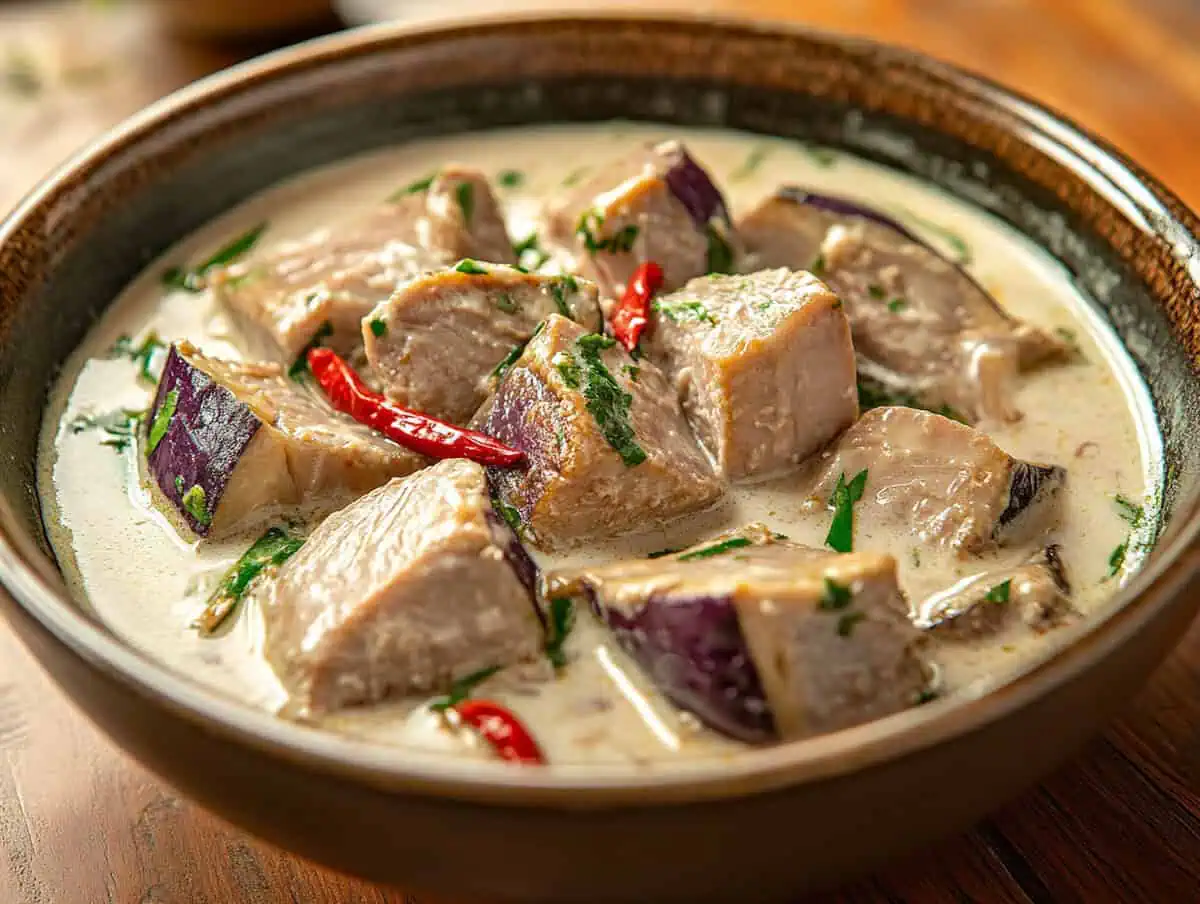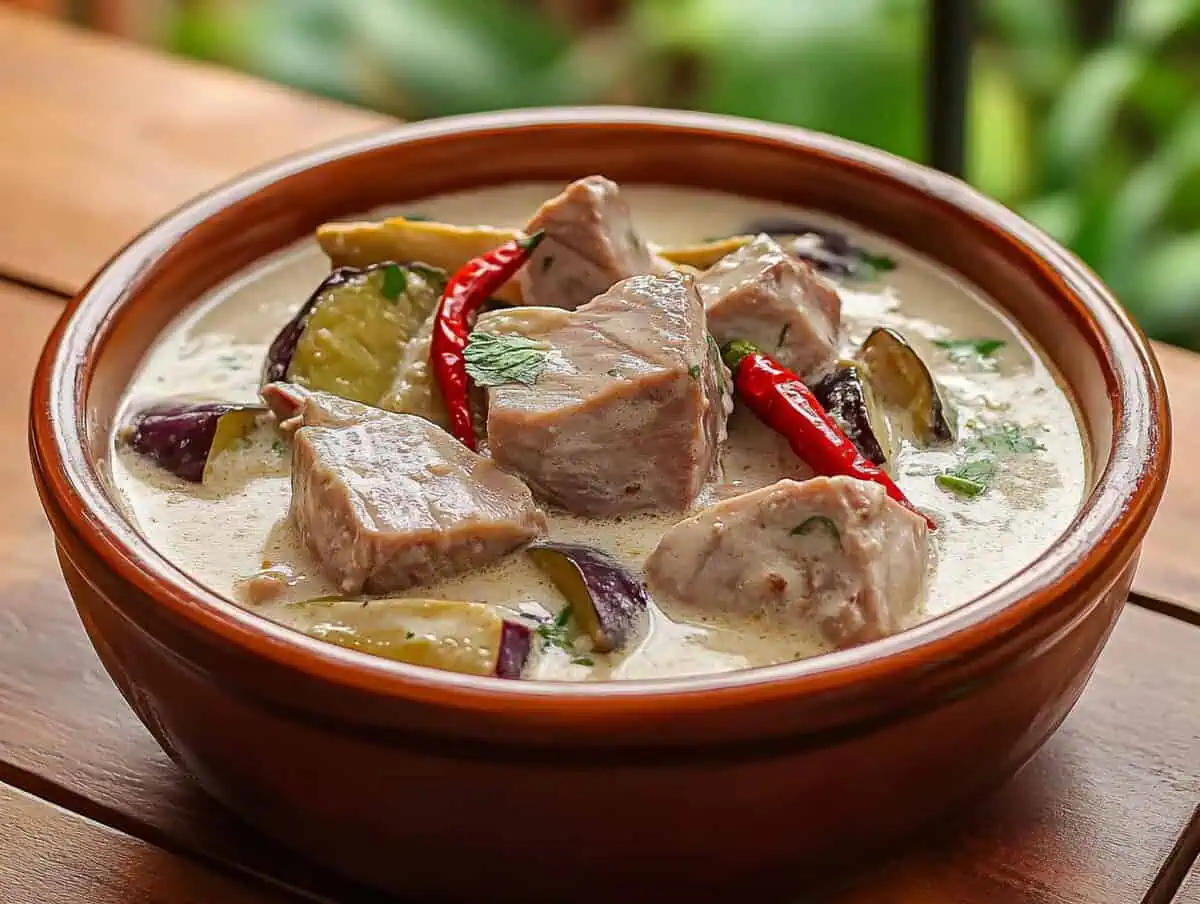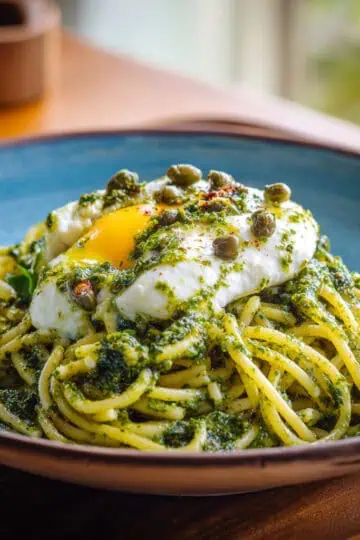Welcome to Kusina Secrets! Today I'm sharing one of my favorite Filipino seafood dishes that's been a family favorite for years. This Ginataang Tulingan combines fresh bullet tuna with creamy coconut milk, aromatic spices, and tender vegetables for an incredible flavor experience.
While it does take some time to cook, I promise the results are absolutely worth it! The fish turns out perfectly tender with no fishy taste, and the rich coconut sauce is absolutely divine when spooned over hot rice.
I've perfected this recipe through many Sunday family gatherings, and I'm excited for you to try it in your own home.
What is Ginataang Tulingan?
Ginataang Tulingan is a classic Filipino dish where bullet tuna (tulingan) is cooked in coconut milk (gata) along with eggplant and other aromatic ingredients. The term "ginataan" refers to any Filipino dish cooked with coconut milk. Tulingan, also known as bullet tuna or bonito, is a small to medium-sized saltwater fish common in Philippine waters.
Jump to:
Why You'll Love This Recipe
This delicious Filipino dish combines tender bullet tuna with creamy coconut milk and fresh vegetables for a truly authentic taste experience. The long simmering process with bilimbi (kamias) eliminates the fishy aftertaste, while the coconut milk creates a rich, flavorful sauce that perfectly complements the fish. It's a complete meal when served with rice, making it ideal for family dinners or special occasions.
This recipe strikes the perfect balance between traditional Filipino cooking techniques and accessible ingredients. The result is a dish with complex flavors that will transport you straight to the Philippines with every bite.
Ingredients
I've carefully selected each ingredient in this recipe for a specific purpose. The bullet tuna forms our protein base, while pork fat adds richness that complements the fish. Coconut milk creates our creamy sauce, and kamias (bilimbi) works to eliminate any fishy taste.
Ginger, garlic, onion and Thai chilies build our aromatic flavor base, while eggplant absorbs the delicious sauce and adds texture. Fish sauce (patis) provides that umami depth that makes Filipino cooking so special. It's a simple combination that creates complex, balanced flavors.

- 4 pieces tulingan (bullet tuna)
- 3 ounces pork fat, sliced
- 2 cups coconut milk
- 10 pieces kamias (bilimbi)
- 3 thumbs ginger, julienned
- 5 pieces Thai chili pepper
- 1 piece eggplant, sliced
- 1 onion, sliced
- 5 cloves garlic, crushed and minced
- 1 teaspoon patis (fish sauce)
- 1¾ cups water
- Salt and ground black pepper to taste
Equipment
- Large heavy-bottomed pot with lid
- Sharp knife
- Cutting board
- Measuring cups and spoons
- Wooden spoon or heat-resistant spatula
- Serving platter

How To Make
- Prepare the fish: Clean the tulingan thoroughly. Create a slit on both sides of each fish and rub salt all over. Let it rest for 10 to 15 minutes to eliminate some of the fishy smell.
- First cooking stage: In a large pot, arrange the pork fat, kamias (bilimbi), fish, and ginger. Pour in the water. Cover and bring to a boil. Continue to cook on medium heat for 40 minutes. This process helps remove the fishy aftertaste and tenderizes the fish.
- Add coconut milk: Pour the coconut milk into the pot. Add the garlic, onion, and chili peppers. Cover and continue to boil for another 40 minutes using low to medium heat. The extended cooking time allows the flavors to meld together beautifully.
- Add vegetables: Add the eggplant slices to the pot. Cook for 5 to 7 minutes until the eggplant is tender but not mushy.
- Season and serve: Season with patis (fish sauce) and ground black pepper to taste. Transfer to a serving plate and serve hot with steamed rice.

Tips from Lola's Kitchen
- Select fresh fish: Always choose fresh tulingan with clear eyes and firm flesh. The fresher the fish, the better the dish will taste.
- Don't rush the cooking: The long simmering time is crucial for developing flavors and tenderizing the fish. Be patient and avoid the temptation to increase the heat.
- Control the spice level: Adjust the number of Thai chili peppers based on your preference for spiciness. For a milder version, remove the seeds or reduce the quantity.
- Balance the flavors: Taste before serving and adjust the seasoning. If it's too rich, add a little more patis or a squeeze of calamansi juice for brightness.
- For extra creaminess: Add ½ cup of coconut cream (kakang gata) during the last 15 minutes of cooking for an even richer sauce.
Substitutions
- Fish options: If tulingan is unavailable, you can use mackerel (tanigue), milkfish (bangus), or any firm-fleshed fish. Adjust cooking time based on the size and thickness of the fish.
- Souring agent: No bilimbi? Use green tamarind, green mango, or calamansi juice as alternatives. Each will give a slightly different flavor profile.
- Pork fat alternative: For a lighter version, substitute with 2 tablespoons of cooking oil. However, the pork fat adds a distinctive richness to the dish.
- Vegetable additions: Feel free to add other vegetables like string beans, okra, or bell peppers for extra nutrition and color.
- Coconut milk: In a pinch, you can use canned coconut milk, but fresh is always preferred for authentic flavor.
Troubleshooting
- Fish falling apart: If your fish is breaking apart during cooking, it might be overcooked or the heat might be too high. Keep the heat at medium-low and handle the fish gently when serving.
- Sauce too thin: If the sauce is too watery, remove the lid and simmer on low heat until it reduces to your desired consistency.
- Sauce curdling: If the coconut milk starts to curdle, lower the heat immediately and avoid boiling vigorously after adding the coconut milk.
- Too fishy taste: Increase the amount of ginger and kamias next time, or soak the fish in vinegar for 5 minutes before cooking (then rinse well).
- Too spicy: If the dish turns out too spicy, add more coconut milk or serve with extra rice to balance the heat.
Storage & Reheating
- Refrigeration: Store leftovers in an airtight container in the refrigerator for up to 2 days. The flavors often improve overnight as they continue to meld together.
- Freezing: This dish can be frozen for up to 1 month, though the texture of the eggplant may change slightly upon thawing.
- Reheating: Gently reheat on the stovetop over low heat until just warmed through. Avoid boiling as it can cause the coconut milk to separate and the fish to become tough. Add a splash of water or coconut milk if the sauce has thickened too much during storage.

FAQ
Why does this recipe take so long to cook?
The extended cooking time serves two purposes: it helps remove the fishy taste from the tulingan and allows the flavors to develop fully. Bullet tuna is a tough fish that benefits from longer cooking.
Can I make this dish less spicy?
Absolutely! Reduce the number of Thai chili peppers or remove them entirely. You can also remove the seeds from the chilies for a milder heat.
What can I substitute for bilimbi (kamias)?
Green tamarind, green mango, or calamansi juice can work as substitutes. Each will provide the necessary acidity, though with slightly different flavor profiles.
Can I use canned coconut milk?
Yes, canned coconut milk works well in this recipe. Use about 2 cups or a 14-16 oz can.
What makes the sauce turn bitter sometimes?
Bitterness usually comes from overcooking the coconut milk or boiling it at too high a temperature. Keep the heat low to medium after adding the coconut milk and avoid rapid boiling.
Can I add other vegetables to this dish?
Yes! String beans, okra, bell peppers, and spinach all work well in this dish. Add firmer vegetables earlier in the cooking process and leafy greens toward the end.
Is this dish healthy?
Ginataang Tulingan contains nutritious ingredients like fish (high in protein and omega-3 fatty acids), vegetables, and spices. However, the coconut milk makes it relatively high in fat. For a lighter version, you can reduce the amount of coconut milk or substitute some with water.
Can I make this in advance for a party?
Yes, this dish often tastes even better the next day as the flavors continue to develop. Reheat gently before serving.
Related
Looking for other recipes like this? Try these:

Ginataang Tulingan (Bullet Tuna in Coconut Milk)
Ingredients
- 4 pieces tulingan bullet tuna
- 3 ounces pork fat sliced
- 2 cups coconut milk
- 10 pieces kamias bilimbi
- 3 thumbs ginger julienned
- 5 pieces Thai chili pepper
- 1 piece eggplant sliced
- 1 onion sliced
- 5 cloves garlic crushed and minced
- 1 teaspoon patis fish sauce
- 1¾ cups water
- Salt and ground black pepper to taste
Instructions
- Prepare the fish: Clean the tulingan thoroughly. Create a slit on both sides of each fish and rub salt all over. Let it rest for 10 to 15 minutes to eliminate some of the fishy smell.
- First cooking stage: In a large pot, arrange the pork fat, kamias (bilimbi), fish, and ginger. Pour in the water. Cover and bring to a boil. Continue to cook on medium heat for 40 minutes. This process helps remove the fishy aftertaste and tenderizes the fish.
- Add coconut milk: Pour the coconut milk into the pot. Add the garlic, onion, and chili peppers. Cover and continue to boil for another 40 minutes using low to medium heat. The extended cooking time allows the flavors to meld together beautifully.
- Add vegetables: Add the eggplant slices to the pot. Cook for 5 to 7 minutes until the eggplant is tender but not mushy.
- Season and serve: Season with patis (fish sauce) and ground black pepper to taste. Transfer to a serving plate and serve hot with steamed rice.
Tips from Lola's Kitchen
- Select fresh fish: Always choose fresh tulingan with clear eyes and firm flesh. The fresher the fish, the better the dish will taste.
- Don't rush the cooking: The long simmering time is crucial for developing flavors and tenderizing the fish. Be patient and avoid the temptation to increase the heat.
- Control the spice level: Adjust the number of Thai chili peppers based on your preference for spiciness. For a milder version, remove the seeds or reduce the quantity.
- Balance the flavors: Taste before serving and adjust the seasoning. If it's too rich, add a little more patis or a squeeze of calamansi juice for brightness.
- For extra creaminess: Add ½ cup of coconut cream (kakang gata) during the last 15 minutes of cooking for an even richer sauce.
The Story Behind Ginataang Tulingan
Growing up in coastal Filipino communities, Ginataang Tulingan has been a treasured recipe passed down through generations. This humble yet flavorful dish originated in fishing villages where fresh tuna was abundant and families needed hearty, satisfying meals after long days at sea.
The practice of cooking fish in coconut milk (gata) dates back centuries in Filipino cuisine, combining indigenous ingredients with techniques influenced by Malay, Chinese, and later Spanish culinary traditions. What makes Ginataang Tulingan special is how it transforms a sometimes strong-flavored fish into a delicacy through patient cooking and clever use of souring agents.
In the Philippines, particularly in the Bicol and Southern Tagalog regions where coconut trees flourish along coastlines, variations of this recipe can be found in nearly every household. Each family puts their unique spin on it – some adding more chilies for heat, others incorporating local vegetables based on seasonal availability.
The bilimbi fruit (kamias) plays a crucial role in this recipe, not just for flavor but as a natural tenderizer. Before refrigeration was common, these acidic fruits helped preserve fish and reduce fishiness, making them essential in traditional Filipino cooking. This practical solution evolved into a distinctive flavor profile that Filipino food lovers now seek out specifically.
Today, Ginataang Tulingan represents the heart of Filipino food culture – resourcefulness, bold flavors, and the ability to create something extraordinary from simple ingredients. Whether served for everyday family meals or during special celebrations, this dish brings people together around the table to share not just food, but stories and heritage.










Comments
No Comments